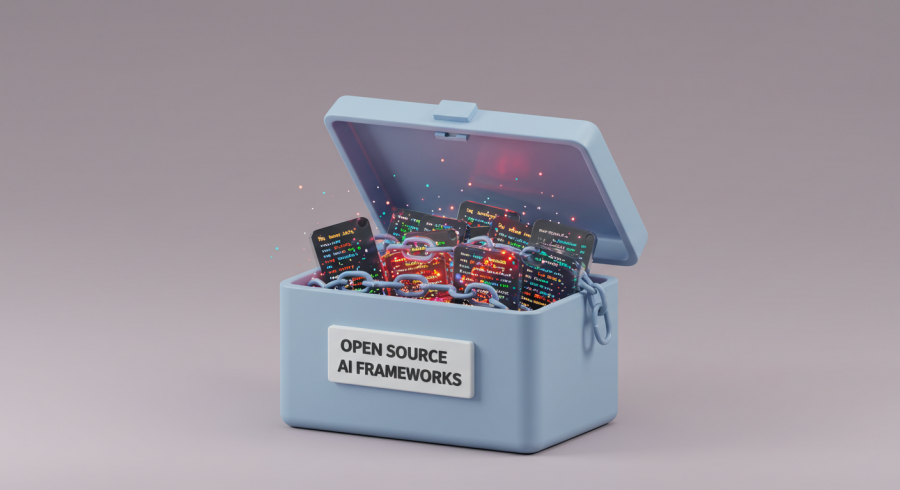Open Source Prompt Chain Frameworks 2025
These Open-Source Tools Are Revolutionizing How Developers Build
Is coding complex AI workflows keeping you up at night? Frustrated with endless lines of code and slow development cycles? You're not alone. But what if we told you there's a secret weapon emerging in the AI world, one that's poised to revolutionize how developers build intelligent applications? It's called open-source prompt chain frameworks, and they are changing everything. Forget painstakingly crafting every AI interaction from the ground up. These frameworks are like pre-fabricated construction kits for AI, offering developers ready-made tools and libraries to assemble powerful, custom workflows with unprecedented speed and efficiency. Think of it as the democratization of AI development – powerful tools, freely available, and ready to unleash the next wave of AI innovation. Developers, listen up: this is how you'll be building AI in the future.
II. Top Open-Source Frameworks for Building Prompt Chains
Here are some of the leading open-source frameworks empowering developers to build custom prompt chains:
-
LangChain: A dominant framework in the prompt engineering space, LangChain is designed for building applications powered by language models. Its key strength lies in its chain abstraction, allowing developers to easily create and manage complex sequences of prompts and model calls. LangChain boasts a rich set of features including components for various LLMs, prompt management tools, memory capabilities, agentic functionalities, callbacks for workflow monitoring, and seamless integrations with numerous external tools and services. It's ideally suited for complex applications requiring sophisticated LLM orchestration, such as chatbots, data augmentation pipelines, and agentic workflows that automate intricate tasks.
-
Haystack: For developers focused on search systems and applications leveraging large language models, Haystack is a powerful open-source framework. Haystack excels at building pipelines for document retrieval and question answering. It provides pre-built, production-ready components for indexing large volumes of text data, querying with sophisticated search strategies, and implementing effective prompting techniques. Haystack is particularly well-suited for knowledge base applications, document search engines, question answering systems, and Retrieval-Augmented Generation (RAG) implementations, where grounding AI responses in reliable information is crucial.
-
Meltano: While not solely focused on prompt chaining, Meltano is a versatile open-source platform that proves invaluable for orchestrating the data flow within complex AI workflows. As a robust open-source platform for building and managing data pipelines, Meltano can be effectively used to orchestrate the data flow that fuels sophisticated prompt chains. Its core strength lies in its ELT (Extract, Load, Transform) pipeline capabilities, enabling seamless integration with diverse data sources and destinations. Meltano's workflow orchestration features and extensible plugin system make it ideal for data-intensive prompt chains and for building AI-powered data applications that require robust data integration and transformation capabilities.
-
Semantic Kernel: Developed by Microsoft, Semantic Kernel is an open-source SDK that allows developers to easily integrate large language models into their applications. Semantic Kernel provides a flexible and extensible architecture for building prompt chains, emphasizing a plugin-based approach. Key features include prompt templating, function orchestration (allowing you to combine native code with LLM calls), contextual memory, and support for different AI models. Semantic Kernel is well-suited for developers building intelligent agents, integrating AI into existing applications, and creating complex workflows that blend code and natural language processing.
- OpenManus provides a modular framework for building sophisticated, collaborative AI systems. Its key strength lies in its multi-agent design, allowing developers to construct AI workflows where specialized "teams" of agents, managed by a central "project manager," tackle complex tasks in concert. Designed for accessibility, OpenManus prioritizes ease of setup and deployment, utilizing Docker and a straightforward configuration file. This makes it an ideal platform for developers looking to rapidly prototype, experiment with, and contribute to the evolving landscape of multi-agent AI systems and complex prompt orchestration.
- Configuration: Two installation methods. Method 1 (using uv) is recommended for faster installation and better dependency management. Method 2 using Conda.
- Link: OpenManus Github
-
Dust.tt: Dust.tt is an open-source platform designed to streamline the development, deployment, and management of AI applications, including those built with prompt chains. It provides a comprehensive toolkit for building and iterating on AI workflows.
- Key Features: Visual workflow editor, collaborative workspace, version control for prompts and workflows, built-in evaluation and testing tools, deployment infrastructure, integrations with various LLMs and data sources.
- Ideal Use Cases: Rapid prototyping of AI applications, collaborative AI development projects, building and deploying production-ready AI workflows, managing complex AI systems.
- Link: Dust.tt Website
-
OpenPrompt: OpenPrompt is an open-source framework specifically focused on prompt learning and prompt engineering. It's designed to facilitate research and development in prompt-based learning techniques.
- Key Features: Diverse collection of prompt templates and verbalizers, support for various prompt learning paradigms (e.g., cloze-style, prefix-style), flexible framework for defining and customizing prompts, tools for evaluating prompt performance, integration with popular NLP libraries.
- Ideal Use Cases: Research on prompt engineering techniques, experimenting with different prompting strategies, developing and evaluating novel prompt learning methods, educational purposes for understanding prompt learning.
- Link: OpenPrompt Website
-
BetterPrompt: While "BetterPrompt" as a distinct, widely recognized open-source framework for prompt chaining is less prominent, the term itself embodies the principle of improving prompt quality. It's more of a concept than a specific tool. However, if you intended to refer to a specific project, please clarify the name or provide a link, and I can create a section for it. In the absence of a specific "BetterPrompt" framework, I will focus on the concept:
- BetterPrompt (Concept): "BetterPrompt" represents the ongoing effort in prompt engineering to refine and improve prompts for enhanced AI performance. It's not a single tool, but a philosophy of iterative prompt optimization.
- Key Features (Conceptual): Prompt refinement techniques, iterative testing methodologies, focus on clarity and specificity in prompts, strategies for reducing bias and improving output quality, A/B testing of prompt variations.
- Ideal Use Cases (Conceptual): Any prompt chain development process benefits from the "BetterPrompt" approach. It's essential for achieving optimal results in all applications of prompt chaining by emphasizing continuous improvement and refinement.
- Link: (Conceptual - No specific tool link, but can link to general prompt engineering resources if desired)
-
Prompt Engine: Prompt Engine is an open-source Python library designed to simplify prompt management and organization, particularly for complex prompt chains. It provides tools for structuring, storing, and retrieving prompts efficiently.
- Key Features: Prompt templates with variables, hierarchical prompt organization, prompt versioning, support for different prompt formats, easy integration into Python projects, command-line interface for prompt management.
- Ideal Use Cases: Managing large collections of prompts, organizing prompts for complex applications, version controlling prompts for iterative development, streamlining prompt usage in Python-based AI workflows.
- Link: Prompt Engine GitHub Repository
-
Promptify: Promptify is an open-source framework aimed at making it easier to apply prompt engineering techniques to various NLP tasks. It focuses on simplifying the process of creating and using prompts for tasks like text classification, information extraction, and text generation.
- Key Features: Abstraction layer for prompt creation, pre-defined prompt templates for common NLP tasks, support for different prompting methods (e.g., few-shot, cloze), tools for evaluating prompt effectiveness, integration with various NLP models.
- Ideal Use Cases: Rapid prototyping of prompt-based NLP applications, simplifying prompt engineering for common NLP tasks, experimenting with different prompting techniques, educational purposes for learning prompt engineering.
- Link: Promptify GitHub Repository
-
PromptFlow (by Microsoft): PromptFlow (from Microsoft, though increasingly open and community-driven) is a development tool designed to streamline the end-to-end lifecycle of prompt engineering, from creation and experimentation to evaluation and deployment.
- Key Features: Visual flow-based interface for building prompt chains, collaborative environment for prompt development, built-in evaluation and testing capabilities, integration with Azure AI services and other LLMs, version control and experiment tracking, deployment options for Azure.
- Ideal Use Cases: Collaborative prompt engineering workflows, building and evaluating complex prompt chains, deploying prompt-based AI applications on Azure, managing the entire lifecycle of prompt engineering projects.
- Link: PromptFlow Documentation
- ThoughtSource: ThoughtSource is an open-source Python library and framework designed to facilitate complex reasoning and knowledge-intensive tasks using large language models. It focuses on enabling AI to perform multi-step reasoning by integrating different prompting strategies and knowledge sources.
- Key Features: Framework for building Chain-of-Thought reasoning workflows, modular design for integrating various knowledge sources (e.g., knowledge graphs, databases, search engines), tools for prompt composition and management, support for iterative reasoning processes, utilities for evaluating reasoning accuracy, extensible architecture for custom knowledge integration.
- Ideal Use Cases: Complex question answering, knowledge-intensive reasoning tasks, building AI systems that require multi-step inference, applications in scientific research, data analysis, and domains requiring verifiable reasoning processes.
- Link: ThoughtSource GitHub Repository
III. Choosing the Right Framework
Selecting the optimal framework depends on the specific needs of your project. Consider these factors:
- Project Requirements: Clearly define the complexity, scope, and specific functionalities of your AI workflow. Are you building a simple chatbot or a complex data analysis pipeline? The scale and nature of your project will influence framework suitability.
- Framework Features: Evaluate if a framework offers the necessary components and integrations for your intended workflow. Do you need robust agentic capabilities? Strong data integration? Specific LLM integrations?
- Community & Support: A vibrant community ensures ongoing development, readily available support, and a wealth of examples and tutorials. Check for active forums, documentation quality, and community contributions.
- Learning Curve: Consider your team's existing skill set and the framework's learning curve. Some frameworks are more beginner-friendly, while others offer greater power but require more expertise.
- Licensing: Ensure the open-source license is compatible with your project's requirements, especially for commercial applications.
IV. Getting Started with Open-Source Prompt Chain Development
Embarking on prompt chain development with open-source frameworks typically involves these steps:
- Installation: Begin by installing your chosen framework, usually via package managers like pip or npm, following the framework's documentation.
- Core Concepts: Familiarize yourself with the framework's terminology, key classes, and core components through tutorials and documentation.
- Building a Simple Chain: Start with a basic example project to solidify your understanding. Most frameworks offer quick start guides and example code to get you going.
- Experimentation & Iteration: Prompt engineering is iterative. Experiment with different prompts, chain structures, and framework features to optimize your workflows.
- Deployment Considerations: Plan for deployment early on. Frameworks offer varying levels of support for different deployment environments, from local servers to cloud platforms.
V. Conclusion
Open-source frameworks are revolutionizing the way developers build AI applications. By providing robust, pre-built tools for prompt chaining, these libraries significantly accelerate development, reduce complexity, and foster innovation. Instead of reinventing the wheel, developers can now leverage these powerful frameworks to create sophisticated, custom AI workflows with greater speed and efficiency. Open-source frameworks are democratizing AI development, empowering developers to build the next generation of intelligent applications and unlock the full potential of AI workflows. Ready to build your own custom prompt chains? Dive into these frameworks and unleash the power of AI workflows today!
VI. Further Resources
- LangChain:
- Haystack:
- Meltano:
- Semantic Kernel:






Comments (0)